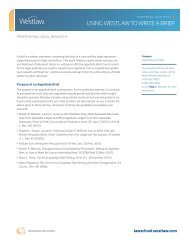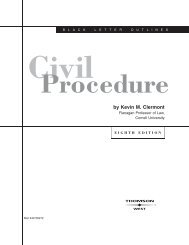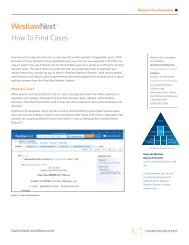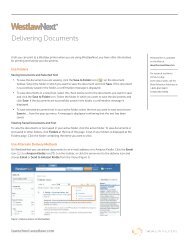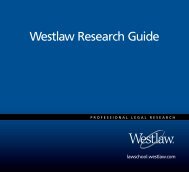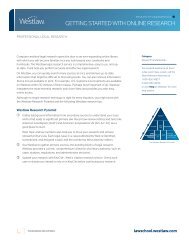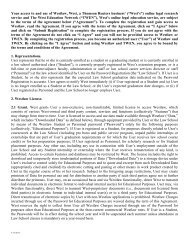Winning Research Skills - Westlaw
Winning Research Skills - Westlaw
Winning Research Skills - Westlaw
You also want an ePaper? Increase the reach of your titles
YUMPU automatically turns print PDFs into web optimized ePapers that Google loves.
Chapter 2<br />
Using Case Digests<br />
Digests contain abstracts of cases organized by subject. Digests are particularly useful for<br />
identifying cases when you are researching a legal issue (such as when a bailment is created) or<br />
concept (such as promissory estoppel). Every digest includes headnotes and a subject<br />
arrangement that organizes the legal issues summarized in the headnotes.<br />
The digests we will discuss are published by West. Although other companies also publish<br />
digests, West has the largest system—the only one that covers all jurisdictions. You will often<br />
obtain the best results by using digests in conjunction with <strong>Westlaw</strong>, but let’s examine how to<br />
use a digest alone to find the information you need.<br />
The digest contains a comprehensive list of legal topics. Each legal topic is subdivided into<br />
issues, and each issue is assigned a digest classification number called a key number. Listed<br />
under each key number are headnotes from reported cases addressing the issue. Remember that<br />
West attorney-editors create headnotes by isolating and summarizing every issue of law that<br />
appears in the opinion and assigning topics and key numbers to each headnote. Each headnote is<br />
assigned at least one key number, and some headnotes are assigned several.<br />
Understanding the relationship between the headnotes and the digests is crucial to using the<br />
digests. The paragraphs in the digests are basically the headnote paragraphs from the cases in the<br />
reporters, rearranged according to subject. Headnotes from different cases that discuss the same<br />
point of law appear together in a digest, and the same headnote may appear in two or more<br />
places in the digest.<br />
Understanding the West Key Number System<br />
West organizes its digests according to the West Key Number System. In this system, the entire<br />
body of law is broken down into general topics (e.g., Animals). Each topic is further divided into<br />
points of law (e.g., persons liable for injuries). A key number (e.g., 54) is assigned to each point<br />
of law.<br />
Animals 54<br />
You must use both parts, the topic and the key number, in order to use the digests.<br />
In a digest, the paragraphs under a key number are arranged by jurisdiction. The paragraphs<br />
under each jurisdiction are arranged by date of decision, in reverse chronological order.<br />
The beauty of the West Key Number System is that the key number assigned to a point of law is<br />
uniform throughout all of West’s digests. As a result, when you find a relevant case in the<br />
Washington Digest, for example, you can look under the same key number in the Pacific Digest<br />
and find other relevant cases. Keep in mind, however, that a particular regional or state digest<br />
may not list any cases under a particular topic and key number because no cases have been<br />
classified under that topic and key number in that jurisdiction.<br />
22 <strong>Winning</strong> <strong>Research</strong> <strong>Skills</strong>







